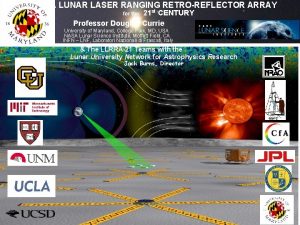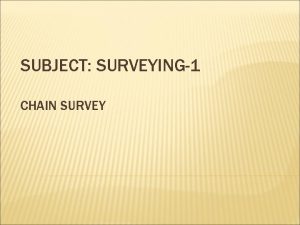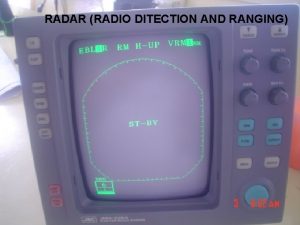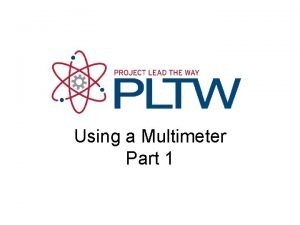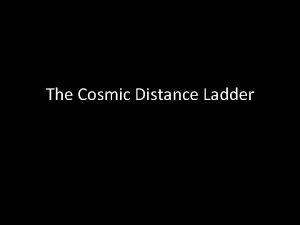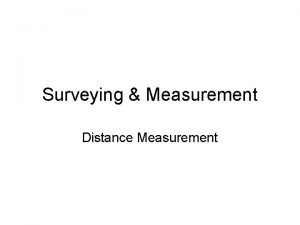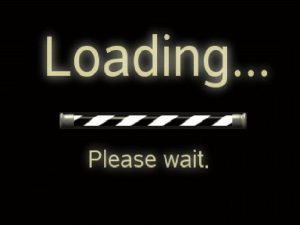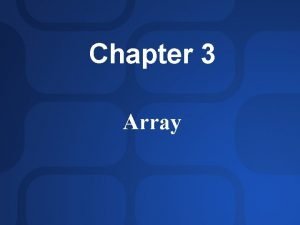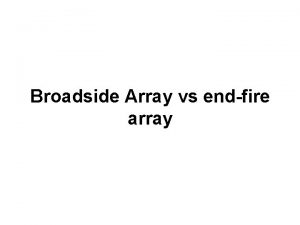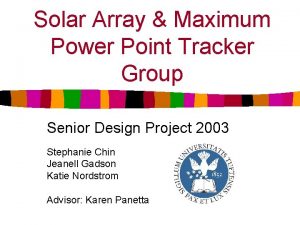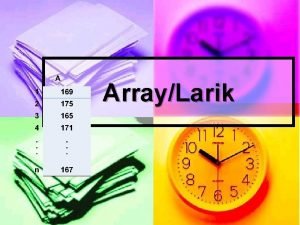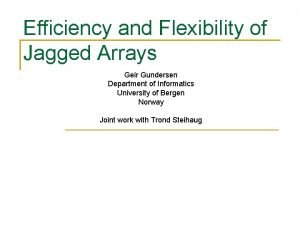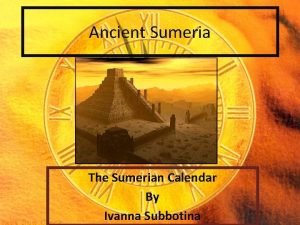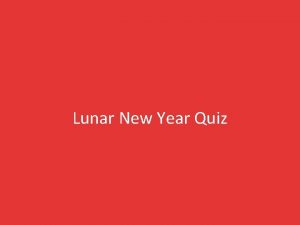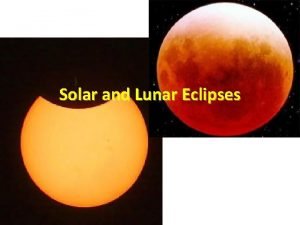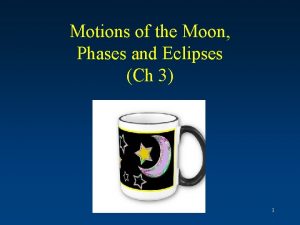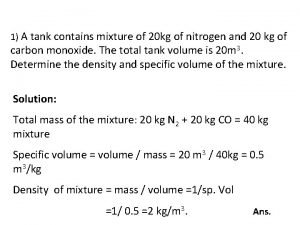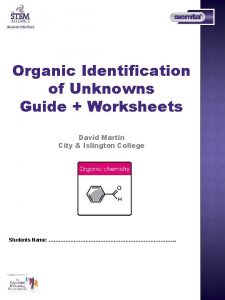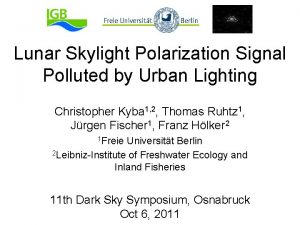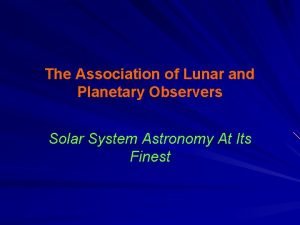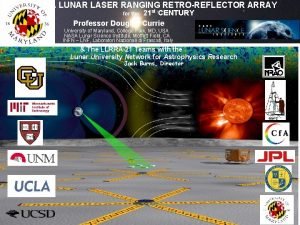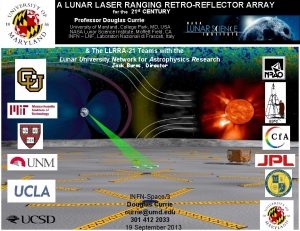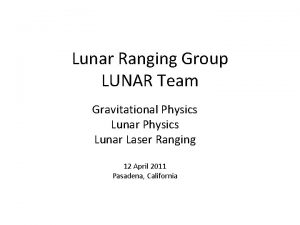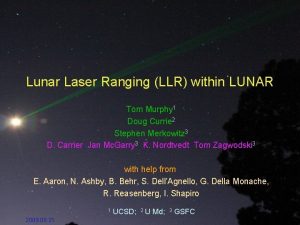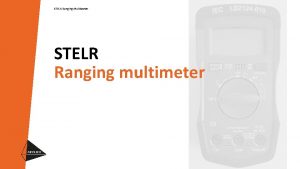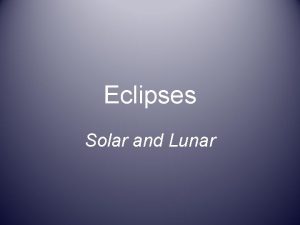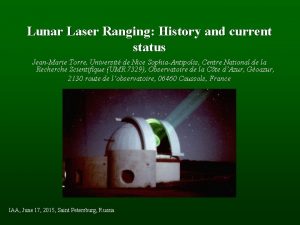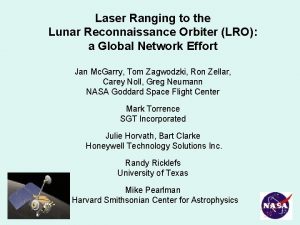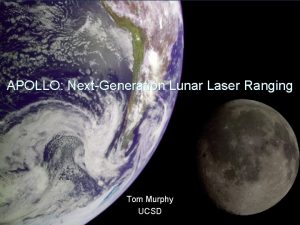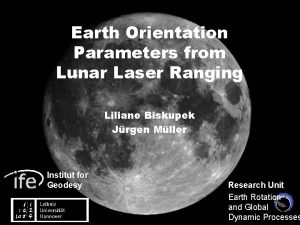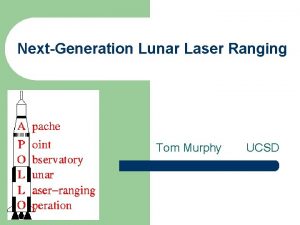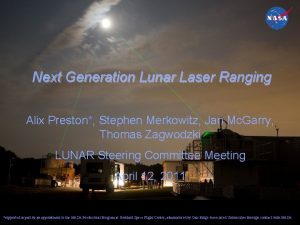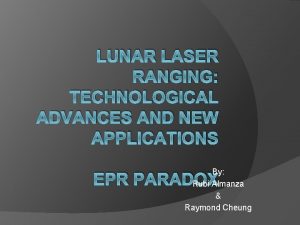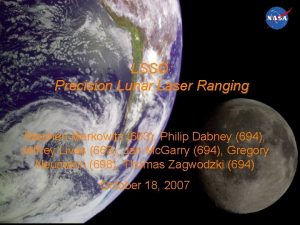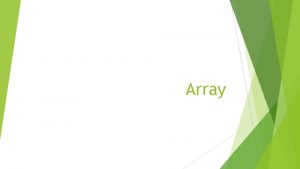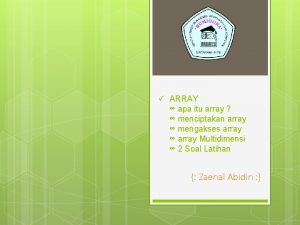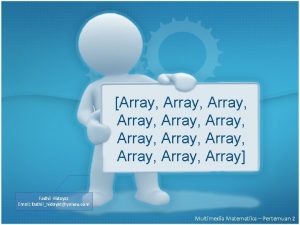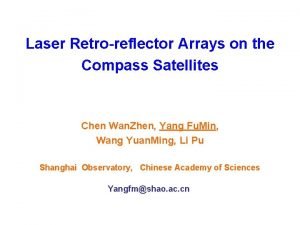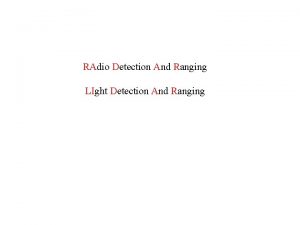A LUNAR LASER RANGING RETROREFLECTOR ARRAY 21 st























- Slides: 23

A LUNAR LASER RANGING RETRO-REFLECTOR ARRAY 21 st CENTURY Professor Douglas Currie for the University of Maryland, College Park, MD, USA NASA Lunar Science Institute, Moffett Field, CA INFN – LNF, Laboratori Nazionali di Frascati, Italy & The LLRRA-21 Teams with the Lunar University Network for Astrophysics Research Jack Burns, Director INFN-Space/3 Douglas Currie currie@umd. edu 301 412 2033 19 September 2013 1

Pre. History of Dicke Group • Professor Robert Dicke of Princeton University – Early Interest in Tests of General Relativity • Measured the Gravitational Red Shift • Investigated the Precession of Mercury • Scalar-Tensor – Brans-Dicke – Alternative to General Releativty – Considered Ranging to the Surface with Spotlight • Insufficient Accuracy – Ranging from the Surface • Insufficient Signal – Outgoing Beam was too Broad – In the 1960’s – Two Great Leaps Forward • Maiman Demonstrated the Laser • Kennedy said We are Going to put a Man on the Moon – Measurements of Sufficient Accuracy • Could Finally be Accomplished!!! NINFN-Space/3 19 September 2013

Brief History of Lunar Laser Ranging • Operational Procedure – – Transmit Narrow Laser Pulse from Earth Pulse is Reflected from a Fixed Point on the Moon Measure the Light Travel Time Analyze Time Series of Measurements for Frequencies • Apollo Range Improvements – Kilometers (Radar) to ~300 mm • Continue for Long Time Series – Originally 3 Ranges per Day INFN-Space/3 19 September 2013 4

LLR LUNAR SCIENCE • • • Discovery of the Inner Liquid Core Dissipation at Liquid-Core/Mantle Interface Physical Librations in Longitude Lunar Moment of Inertia Free Librations – in Crustal Frame Love Numbers of the Crust INFN-Space/3 19 September 2013 5

What have the Apollo Arrays Done Relativity Science • LLR Currently Provides our Tests of: • The Strong Equivalence Principle (SEP) • Nordtvedt parameter = (3 3. 6) · 10 -4 • Time-Rate-of-Change of G • (1 2. 5) · 10 -13 , (4 5) · 10 -15 • Inverse Square Law, Deviation of 1/r – =400 000 km -11 (3 2) · 10 = • Geodetic Precession • Gravitomagnetism INFN-Space/3 19 September 2013 6

LIBRATION PROBLEMS • Why is there a Problem with the Apollo Arrays – Lunar Librations in Tilt Both Axis by 8 degrees – Apollo Arrays are Tilted by the Lunar Librations – CCRs in Corner are Different Ranges by > 10 cm CAM INFN-Space/3 19 September 2013 7

CHALLENGES for a LARGE SOLID CCR • Fabrication of the CCR • Thermal Distortion of Return Beam • Stability of Emplacement INFN-Space/3 19 September 2013 8

CURRENT STATUS • Preliminary Definition of Overall Package • Completed Preliminary Simulations • Completed Phase I Thermal Vacuum Tests INFN-Space/3 19 September 2013 9

LLRRA-21 & Moon. Ex 1 INFN-Space/3 19 September 2013 10

Anchored Deployment Astrobotics & Honeybee INFN-Space/3 19 September 2013 11

Reflector Degradation 100 Reflector Strength (%) what we expect 50 what we really get… 10 0 1% 10% 0 90 180 the full moon curse 270 Lunar Phase Tom Murphy - UCSD 360 12

Preliminary Eclipse Results full shadow § Apollo 11 § Apollo 14 § (Apollo 15)/3. 0 historical peak range @ F. M. robust recovery initially, then down, and brief resurgence once light returns 13 Tom Murphy - UCSD

Apollo Simulation AAS 2102 Anchorage 11 June 2012 14

CONCLUSIONS • LLRRA-21 Will Improve Ranging Accuracy – By a Factor of 10 to 100 – Depending Upon Deployment Method • LLRRA-21 Provides a High Return – Many More Observations/Month – Many More Laser Ground Stations • Ready for Flight in Less than a Year – End of 2015 – Package Weighs Less than 1. 7 kilogram + Pointing – No Power or Communication Required • Google Lunar X Prize • Extremely Cost Effective for the Quality of Science 15 • First Science on Lunar Surface in 45 Years

Thank You! any Questions? or Comments? . with Special Acknowledgements to NASA Lunar Science Sorties Opportunities NASA Lunar Science Institute Italian Space Agency INFN-LNF, Frascati LSSO Team & LUNAR Team. Douglas Currie currie@umd. edu 301 412 2033 16

Apollo 17 - Drilling Jack Schmitt & Gene Cernan AAS Anchorage 11 June 2012 17

PNEUMATIC PROBOSCIS SYSTEM Chris Zacny – Honeybee, Inc. AAS Anchorage 11 June 2012 18

Anchored Deployment Astrobotics & Honeybee AAS Anchorage 11 June 2012 19

NASA Lunar Science Institute US Member Teams CCLADS POLAR CLSE Lunar Dust and Atmosphere Exploration of Lunar Poles Evolution via Samples COSMOLOGY UCSD APOLLO Station LUNAR Astro. Physics CLOE BROWN DREAM Evolution via Bombardment Origin of Terrestrial Planets Dynamics of Exosphere From the Moon Type “Heat. Load Charts” > CR > 1 CR > then when done > exit LUNAR LASER RANGING Lunar Laser Ranging Retroreflector Array for the 21 st Century University of Maryland, College Park LUNAR Webinar 16 April 2012 HELIOPHYSICS GSFC Open CCR 20

Historical Science Results • General Relativity Tests – Strong Equivalence Principle • Different Materials Fall toward the Sun at the Same Rate – Inertial Properties of Gravitational Energy • Moon is Harder to Push due to Inertia of Gravitational Self. Energy – Change of gravitational constant • With Time – 1% in the Life of the Universe • In Space – No Yukawa Behavior of Gravity Between Earth and Moon • Lunar Physics – Liquid Core – discovery, size, shape – “Q” of the Moon – Internal Dissipation – Crustal Properties 21 20 th International Conference on General Relativity and Gravitation

Reflector Degradation 100 Reflector Strength (%) what we expect 50 what we really get… 10 0 1% 10% 0 90 180 the full moon curse 270 Lunar Phase Tom Murphy - UCSD 360 22

Preliminary Eclipse Results full shadow § Apollo 11 § Apollo 14 § (Apollo 15)/3. 0 historical peak range @ F. M. robust recovery initially, then down, and brief resurgence once light returns 23 Tom Murphy - UCSD

CONCLUSIONS • LLRRA-21 - Ready for Flight – Moon Express by end of 2015 – Other GLXP Trams • Pioneering Role of Commercial Transport – Allows Entrance to Space on Science Budgets – Allows Entrance to Space for Many Countries • GLXP has been the “Spark-Plug” for This • Now Need “Taxi Fare” – In the US - National Science Foundation – In Italy - INFN/Italian Space Agency AAS 2102 Anchorage 11 June 2012 24
 Lunar laser ranging retroreflector array
Lunar laser ranging retroreflector array Revenue chain length
Revenue chain length Ditection
Ditection Multimeter manual vs auto ranging
Multimeter manual vs auto ranging Cosmic distance ladder rungs
Cosmic distance ladder rungs Measurement of distance in surveying
Measurement of distance in surveying Diketahui suatu array segitiga memiliki 4 baris dan kolom
Diketahui suatu array segitiga memiliki 4 baris dan kolom Associative array vs indexed array
Associative array vs indexed array Array 2 dimension python
Array 2 dimension python Pga vs lga
Pga vs lga Broadside array and endfire array difference
Broadside array and endfire array difference Photovoltaic array maximum power point tracking array
Photovoltaic array maximum power point tracking array Deklarasi array x adalah int a 2 4 5
Deklarasi array x adalah int a 2 4 5 Arik adalah
Arik adalah Jagged array
Jagged array Chinese new year jeopardy
Chinese new year jeopardy Summerian calendar
Summerian calendar Chinese new year food quiz
Chinese new year food quiz Differentiate between lunar eclipse and solar eclipse
Differentiate between lunar eclipse and solar eclipse Moon phases and eclipses
Moon phases and eclipses A lunar excursion module weighs 1500 kg
A lunar excursion module weighs 1500 kg Lunar survival activity
Lunar survival activity Chris ruhtz youtube
Chris ruhtz youtube Association of lunar and planetary observers
Association of lunar and planetary observers
